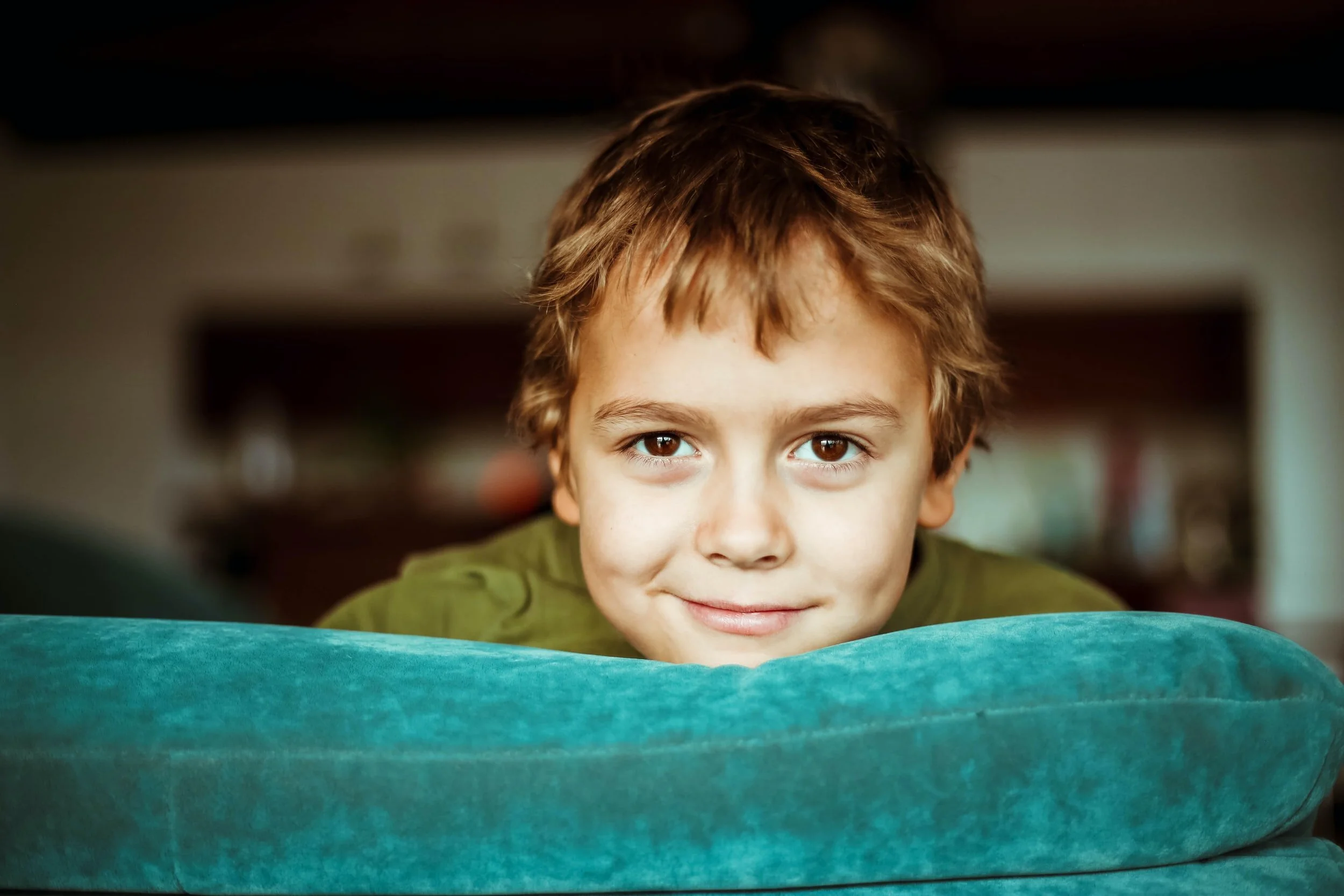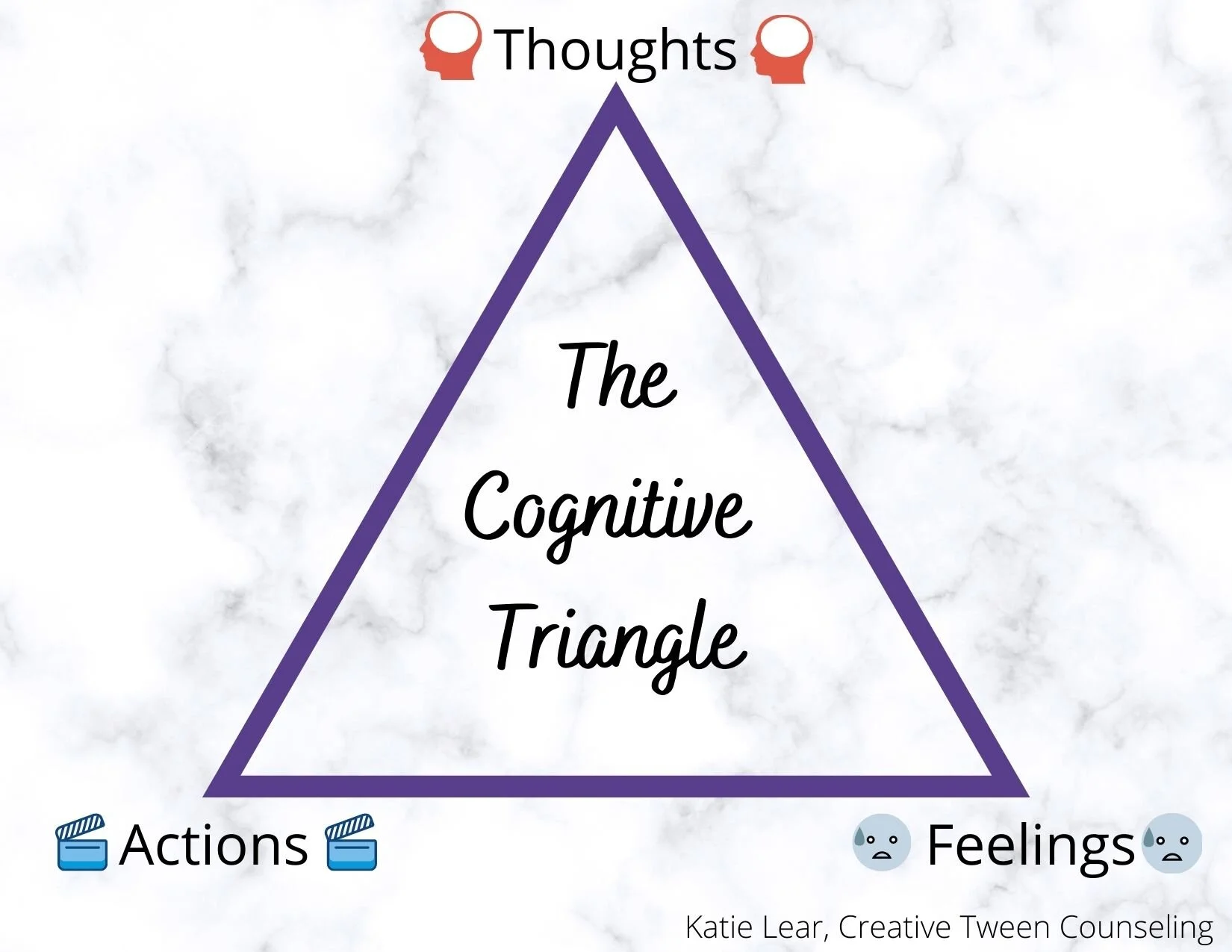Cognitive Behavioral Therapy, also known as CBT, is one of the most effective forms of therapy for children with anxiety. There’s a mountain of research behind it to prove that it helps kids with a variety of anxiety-related problems, from tantrums and acting-out behavior to worrying and sleep difficulties. Although it’s helpful for all ages, studies show it’s especially effective for kids in the 11-13 age range. Maybe that’s why I’m such a big fan of using it in my tween therapy practice!
If you’re reading this post, maybe you are intrigued by CBT, too. It’s possible it’s been recommended to you by your pediatrician, or perhaps you’ve discovered it by Googling around for anxiety treatment for kids. However you learned about it, you might be wondering how to discuss it with your child. As helpful as CBT is, it’s also full of intimidating-sounding therapy jargon. In this post, I’ll break down some of the main concepts in a child friendly way, so your child will be ready to rock their first CBT therapy appointment!
What is Cognitive Behavioral Therapy?
Cognitive Behavioral Therapy is a skill-based therapy that’s used with both kids and adults. It’s a way of dealing with anxiety that’s focused on the present, rather than the past. You probably won’t spend a ton of time in CBT talking about family history and early childhood, because uncovering the root of where anxiety comes from isn’t the main goal of this style of therapy.
Regardless of where the anxiety came from, anxious kids need strategies to deal with it. That’s the main goal of CBT: learning tools to cope with anxiety when it arises, both now and in the future. Although it sounds simple, the effects of CBT can be really deep. Research shows that 70-80% of kids respond well to CBT, and they often see lasting results from short-term therapy. In my experience, learning the right coping skills often leads to an “aha” moment for kids. They start to understand how their own anxiety works, and that they have a say in how they think and feel, which is really empowering.
Common CBT Techniques
A child in CBT therapy might learn any or all of the following techniques:
Relaxation techniques to calm the body
Mindfulness or grounding skills to focus attention during times of stress
Keeping a journal or written log to track worries at home
Practicing “cognitive restructuring”, a way of transforming unhelpful worries
Gradually exposing themselves to things that trigger anxiety
Using roleplay to practice skills
Doing “experiments” in real life to test if their fears really come true
Okay! Now that you’ve got an overview of what CBT is and how it works, let’s move on to talking about how to discuss it with your child. The next 4 sections cover what I think are the most helpful concepts for children to understand about CBT.
CBT Topic #1: The Cognitive Triangle
Most children view their emotions as something that come out of the blue. They come and go, sometimes without good reason, and they’re difficult or impossible to control. Heck, many adults feel this way about their feelings, too: how many times have you heard someone say that something “made them angry” or “made them anxious”? Many of us feel pretty powerless when faced with strong emotions like anxiety and anger.
However, it’s not really true that our feelings come out of nowhere. Any time something happens to us, all day long, we have a thought about it. It’s our thoughts that tell us how we should feel about what’s going on. Most of the time, this process works great and our thoughts let us make accurate judgment calls about situations. But for anxious kids, overly negative thoughts might lead them to feel anxious when they don’t really need to be.
The cognitive triangle is a map that shows how our thoughts, feelings, and behaviors are all connected to each other. Our thoughts tell us how to feel, our feelings influence how we act, and then our actions play a big role in how we see the world and future thoughts we might have. Teaching a child about the cognitive triangle is a great first step when introducing them to CBT.
You can use the cognitive triangle to show how different people can have the same experience, but end up feeling and acting different ways based on their thoughts. For example, a child who loves animals might see a dog sitting on the sidewalk and think “Cute, I love dogs!”. This would make her feel excited and happy. She might walk up to the dog and pet him. Another child who was bitten by a puppy in the past might see the same dog and think “Oh no, he could bite me!”. That would make him feel anxious and afraid. He’d probably cross to the other side of the street to avoid getting near the dog.
Learning and practicing the cognitive triangle helps kids understand that there’s no one “right” way to respond to a situation. It can also help them to notice the vicious cycles that sometimes form when a person is anxious. For example, if the boy in the story above keeps avoiding every dog he sees, he will never get the chance to learn about all the friendly dogs that exist in the world. He may just keep on fearing dogs forever.
CBT Topic #2: Thoughts or Actions Can Change Feelings
Once a child knows about the cognitive triangle, you can move on to the next step. Our thoughts, feelings, and actions are all connected, which means that changing one of those things changes the others. It’s pretty hard to change a feeling: just telling someone to stop being anxious probably isn’t going to work! It’s easier to change our thought or change our actions, and deal with the anxiety that way.
Your child can change her thoughts by learning how to spot worries and turn them into something more useful. She can change your actions by learning coping skills to relax her body and focus on something besides her worries. Either way, she’ll be helping herself to shrink her anxiety down, or turn it into a more helpful feeling to have.
CBT Topic #3: Talking Back to Worries
In CBT, kids learn a process to change their thoughts called “cognitive restructuring.” Because this is pretty much the least child-friendly term ever, I usually just refer to it as “talking back” to thoughts. To practice this technique, kids first need to get skilled at noticing when they’re having a worry. Next, they learn how to gauge whether or not their worry is realistic or not—usually, it isn’t! Finally, they come up with something that is more helpful and realistic they can say to themselves instead.
You can tell your child that in CBT, she’ll learn she doesn’t have to believe everything her worries tell her. Therapy will help her learn how to spot worries, and decide whether or not they’re worth listening to. She’ll learn how to “talk back” to the unhelpful ones, so that they won’t boss her around anymore. Tiger-Tiger, Is It True? is a great book for introducing this concept to preschoolers and early elementary-aged kids. Older kids might benefit from giving my coping skills course a try, where I cover this subject in detail and talk about how to try “talking back” to worries at home.
CBT Topic #4: The Feelings Remote Control
I often use this “remote control” analogy when I’m talking about coping and relaxation skills with kids. Activities like deep breathing, muscle relaxation, and guided visualization are one way that we can change our behavior in order to improve our mood. It can help kids understand the reason we’re always asking them to do things like “take deep breaths.”
When we’re hit with a really intense emotion, sometimes focusing on it just makes it get worse. Kids with anxiety are prone to doing something called ruminating: going over their worries again and again, which magnifies them. Coping skills work like a remote control that helps kids to “change the channel” on their feelings by shifting them into another emotional state. They can also work to “turn the volume down” on an intense emotion, to make it more manageable.
Most kids are familiar with remotes and how they work, which makes these terms helpful shorthand when you’re trying to help your anxious child. Relaxation skills like breathing and muscle relaxing can help turn down the volume, while music, exercise, and guided visualization can help to change the channel.
OK, You’ve Explained CBT to Your Child. What’s Next?
You’ve walked your child through the basics of Cognitive Behavioral Therapy. What’s the next step? If you know this is the approach for you, you can look for a therapist that specializes in CBT on therapist directories like Psychology Today.
If you live in New York, North Carolina, or Florida, I might be able to help you at my tween therapy practice. I love helping kids learn CBT, because these skills don’t have an expiration date: they can help kids manage anxiety and worries for the rest of their lives. That is pretty cool! If you’re not located in a state where I’m licensed, you might like my CBT-inspired coping skills course. It’s a self-guided class (not therapy) for parents and children that teaches my favorite techniques for managing anxiety at home.
I could chat about CBT all day, so if you are curious, feel free to reach out! You can ask a question or request an appointment here.




